When we 'turn the page' from side a to side b of the K tablet we also will move from the top to the bottom, which means from the very old to the very young. The tallest living things are the trees and the idea of high up can be illustrated by a Tree. The contrast to Willow evidently is Star (*), meaning the beginning of the very new (and tiny, ι). In the last 5 days of side a only old Saturn still has his 'head' intact:
Adhafera is ζ Leonis, and we know what this implies: ... Zeta (uppercase Ζ, lowercase ζ; Greek: ζήτα ... is the sixth letter of the Greek alphabet. In the system of Greek numerals, it has a value of 7. It was derived from the Phoenician letter Zayin ... Letters that arose from zeta include the Roman Z and Cyrillic З ... Zayin (also spelled Zain or Zayn or simply Zay) is the seventh letter of many Semitic abjads ... It represents the sound [z]. The Phoenician letter appears to be named after a sword or other weapon. (In Biblical Hebrew, 'Zayin' means sword, and the verb 'Lezayen' means to arm. In modern Hebrew, 'zayin' means penis and 'lezayen' is a vulgar term which generally means to perform sexual intercourse and is used in a similar fashion to the English word fuck, although the older meaning survives in 'maavak mezuyan' (armed struggle) and 'beton mezuyan' (armed, i.e., reinforced concrete) ... Iron bars are necessary to make durable concrete (change 'murky mud' into 'hard land', terra firma). ... ζ, Double, 3.2 and 6, is Burritt's Adhafera, Aldhafara, and Aldhafera, by some confusion perhaps with Al Ashfār of the nearby ε and μ. It is on the crest of the mane, and was one of the manzil Al Jabhah; sometimes taking the latter's name, as in Baily's edition of Ulug Beg. From a point a little to the west of ζ, and not much farther from γ, issue the Leonids, the meteor stream of November 9th to 17th, its maximum now occurring on the 13th-14th, which about every thirty-three years has furnished such wonderful displays, the last in 1866 and the next due in 1899. Their first noticed appearance may have been in the year 137, since which date the stream has completed fifty-two revolutions [137 + 33 * 52 = 1853]. According to Theophanes of Byzantium, the shower was seen from there in November, 472; but the late Professor Newton, our deservedly great authority on the whole subject of meteors, commenced his list of the Leonids with their appearance on the 13th of October, 902, the Arabian Year of the Stars, during the night of the death of King Ibrahim ben Ahmad, and added: It will be seen that all these showers are at intervals of a third of a century, that they are at a fixed day of the year, and that the day has moved steadily and uniformly along the calendar at the rate of about a month in a thousand years. ... Many other meteor streams are visible about the same time as the Leonids, Mr. W. F. Denning having given a list of sixty-eight; the brightest of these, the Ursids, being often mistaken by the casual observer for the Leonids, as their radiant, near μ Ursae Majoris [Tania Australis] is less than 20º distant from the radiant in Leo ... In the K presentation Tania Australis evidently coincides with Gregorian day 236 (= 8 * 29½ days counted from 'January 1), i.e. 256 - 80 = 156 = 12 * 13 days from equinox.
|




